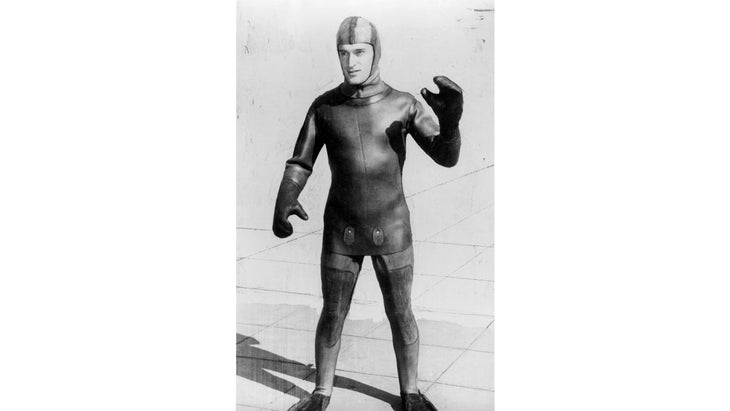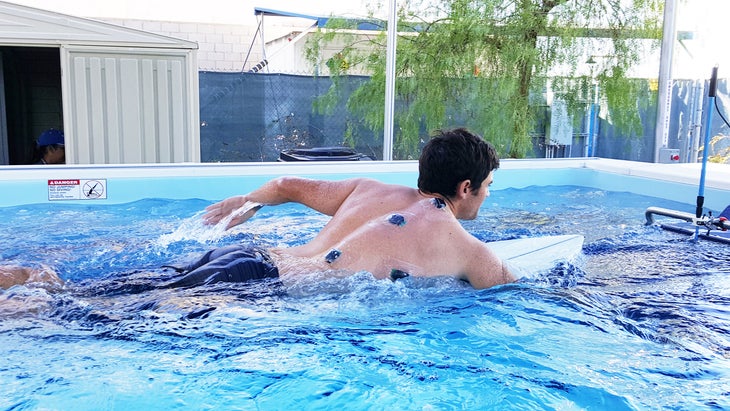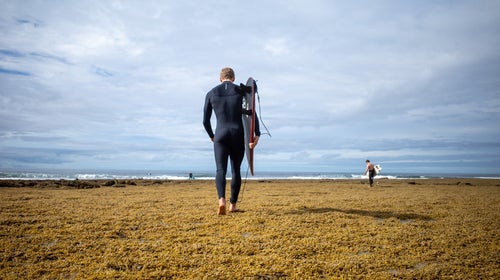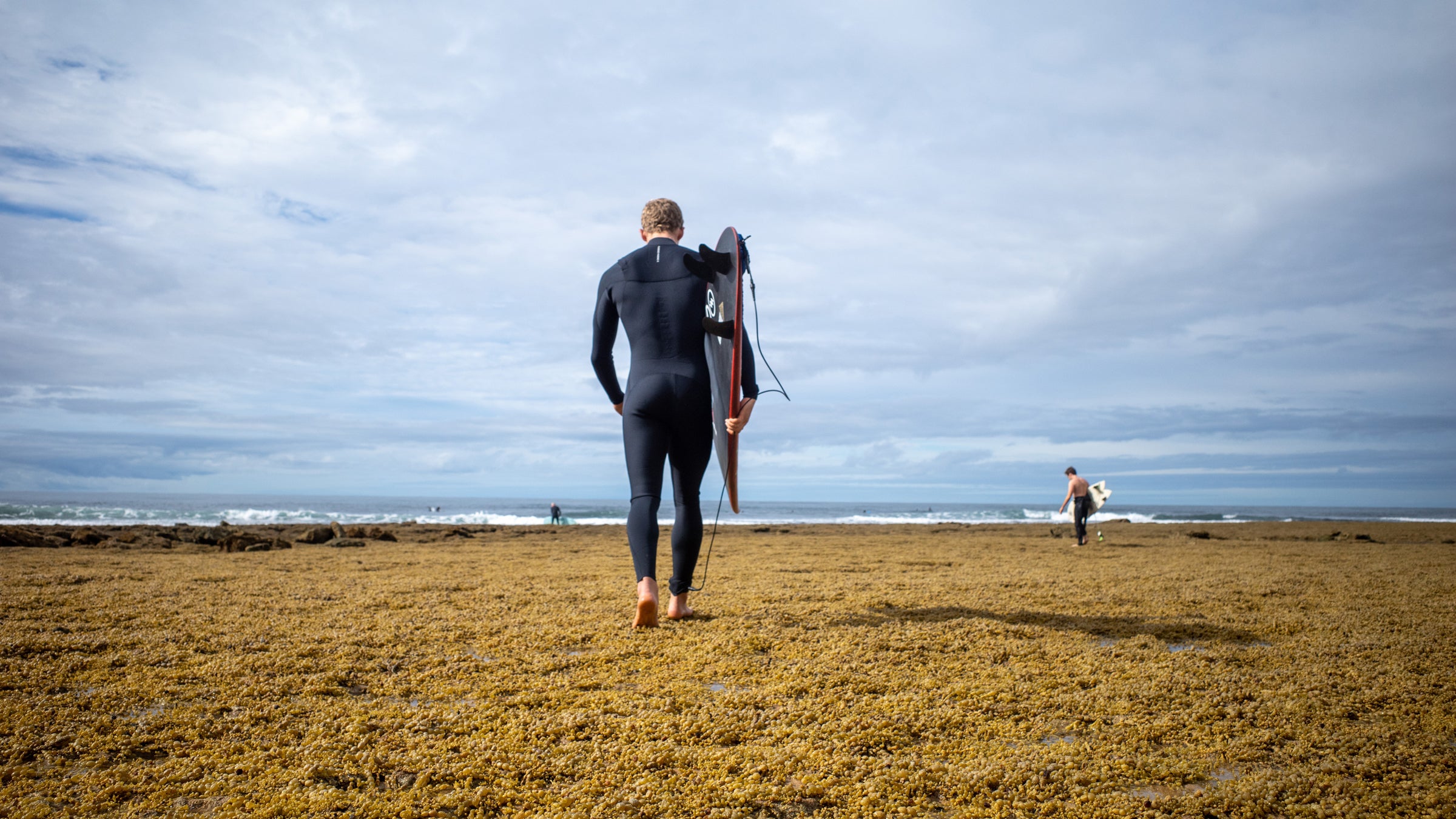A dozen miles from the Pacific Ocean, at California State University in San Marcos, surfers paddle against a current in a temperature-controlled tank. The flume pool is part of the university’s , led by surf-obsessed kinesiology professors Sean Newcomer and Jeff Nessler.
Newcomer (blond, bespectacled, and well-built) and Nessler (lean, bald, and hydrodynamic) are driven by the question of how to use scientific research to make surfing equipment better. To do that, they’ve enlisted the help of 40 undergraduates who are part of Cal State San Marcos’s nine-year-old surf studies program. This kind of niche subject is not profitable for universities or easy to get funding for. “It’s not a sustainable model for a large university to do this research,” Newcomer says. “The way we get around it is it’s part of our educational process; it’s incorporated into our curriculum.”
Ten minutes across campus, the indoor surf laboratories double as classrooms. Motion cameras, a swim bench ergometer, and a treadmill on hydraulics are just placed around the lab, ready to measure how surfers move. Closets are crammed with foam boards, and plastic bins are stuffed with wetsuits from past experiments. Nessler, a mechanical engineer by trade, has even built a few contraptions that exist nowhere else in the country, like a surfboard simulator on pistons that rages like a mechanical bull to mimic riding a wave.
But their main focus has become how wetsuits, the uniform of cold-water surfers, . “We’ve become a wetsuit testing laboratory,” Newcomer says. “The surfing industry doesn’t have a tremendous amount of money for R and D.” That’s too bad, because Newcomer and Nessler’s research has delivered a surprise: wetsuits, even those with inflated prices, thanks to what brands claim are “clinically proven” materials, are not as warm and flexible as they could be. “What the surf industry is marketing is not driven by science,” Newcomer told me.
The first wetsuits, after World War II, were thick and stiff but transformed a diver’s ability to stay warm. Unlike the wool layers and drysuits previously used by the military, these new wetsuits let in a small amount of water, which was heated by the body and insulated against frigid external temperatures. In the 1950s, the nascent surfing industry borrowed from the Navy’s research to create the first commercial wetsuits specifically for the sport. (Surf brand founder Jack O’Neill and businessman Bob Meistrell of the sport’s modern wetsuit design.) Unlike cold-water diving, surfing takes place in two different mediums—air and water—and surfers require much more flexibility than someone who is fully submerged with a scuba tank. So when neoprene made the leap into the industry, designers started making modifications.
Wetsuits now are a far cry from those first dive-based suits, which made natural movements difficult. Products hanging on racks today allow surfers to perform aquatic acrobatics in some of the coldest water on earth. But Hub Hubbard, product line manager for Patagonia’s wetsuit category (and before that at Billabong), told me that many of the design decisions that have been made within the industry over the decades have not been based on hard science. “It’s all been kind of anecdotal,” he says.

This is in large part because even the most committed wetsuit companies struggle to capture real-world data scientifically. Many of these brands conduct materials testing in their labs and collect data on the insulating properties of myriad neoprenes, but it’s often done without a surfer inside. In-ocean testing typically amounts to giving a dozen or so surfers a few wetsuit prototypes and then listening to their feedback. At O’Neill Wetsuits, a core group of about ten surfers try on five or so suits each season and provide feedback, according to Greg Clarke, the brand’s vice president of product development. “We’ve got close to 70 years of trial and error,” he says, on everything from “where the neoprene is placed to the overall comfort and functionality of how the wetsuit fits on the body.”
While these methods have made wetsuits warmer and more flexible over the years, Newcomer and Nessler had a hunch that they could be better.
The professors first realized how much wetsuits could be improved in 2002. Nike had purchased Hurley, bringing its coffers and commitment to science over to the surf industry. Hurley, under Nike, tried modifying a wetsuit with a new material, theorizing that it would improve its thermodynamics. Then the company took a rare step in the wetsuit industry: it asked scientists to design an experiment and collect the necessary data to prove or disprove its hypothesis.
Enter Nessler and Newcomer. They looked into the material that Hurley had incorporated and found that it improved nothing. Bruce Moore, Hurley’s former vice president of innovation, told me that the company kept bringing other wetsuits and raw materials for Nessler and Newcomer to test. “We wanted to see whether they actually worked in the scientific setting or whether they’re just kind of marketing stories and people just selling snake oil,” Moore says.
One material was similar to the Mylar emergency blankets distributed to runners after a marathon. Hurley wanted to see whether the claim that this material reflected more heat back to the body would also be true in the ocean. The results of the study proved the assumption to be false.

Not only did the research for Hurley unveil bogus claims, but the professors also learned new information about what would actually improve wetsuit design. Most modern wetsuits pad the wetsuit’s core with more millimeters of neoprene and decrease the thickness in the extremities. The professors concluded that was actually bad design.
In —the first one published in 2018 and co-authored with a Nike scientist—Newcomer and Nessler used thermal sensors to collect data on regional skin temperatures in recreational surfers wearing 2-millimeter wetsuits. The data showed that the average surfer didn’t need the extra millimeters around their core (unless perhaps they were riding waves near the Arctic Circle). Instead, they needed the thickest neoprene over the lower half of their body—the calves, thighs, stomach, and lower back. Those were the regions submerged in water for the most amount of time and consequently the areas that lost the most heat. Those regions also received the least exposure to the sun and weren’t utilized as much as the upper body’s paddling muscles. (When researchers have tracked surfers’ activity, they’ve found that surfers spend the majority of time paddling during a session, followed by sitting idle. They only actually surf between 2 percent and 5 percent of the time.)
The data showed a difference of nearly 18 degrees between the warmer upper back and the colder skin of the lower legs after a 40-minute surf session. “When you shunt blood away from the extremities, the underlying skeletal muscle suffers,” Newcomer says. That’s part of why sprinters engage in hour-long warm-ups: to circulate warm blood to the legs and arms. “The last thing you want that sprinter to do is sit in an ice bath for 15 minutes before their sprint.”
“What the surf industry is marketing is not driven by science,” Newcomer told me.
The same is true of surfers, who sit in something akin to ice baths: cold oceans. Typical wetsuits don’t efficiently protect against this sort of heat loss in the legs, which means surfers will have decreased force and power in their legs after just a few waves. This affects how well a surfer can pop to their feet and maneuver their board through sections of a wave.
A few years prior to this regional temperature study, Nessler and Newcomer published another paper on wetsuit design with a somewhat obvious takeaway: neoprene restricted a surfer’s ability to paddle. Using that study on kinesthetics, the Cal State researchers wrote in their thermodynamics paper that “the current findings suggest that upper body wetsuit design should be tailored more toward mobility while thermal insulation should be paramount over the lower body.”
Hurley responded positively and built a never before considered wetsuit: 4 millimeters in the legs, 3 millimeters over the lower belly and back, and 2 millimeters in the chest, upper back, and arms. In short, a suit that kept surfers warmer for longer and let them paddle more efficiently throughout the length of their sessions. It seemed like wetsuits were about to be revolutionized.
But then things went south. According to Newcomer, the company’s marketing department found it tricky to sell the science of the final product. Traditionally, wetsuits are named by their thickness. A 4/3-millimeter suit, for instance, is understood to mean that the thickest neoprene (4 millimeters) is wrapped around the core, while the thinnest neoprene (3 millimeters) covers the extremities. Since the new Hurley suit had the thickest neoprene in the legs, thinned as it reached the torso, then thinned some more in the chest and arms, it was confusing to use those traditional measurements. They ended up calling it . While the suit eventually reached customers and is still available today, Hurley kept the science in the smaller print. (Hurley did not respond to �����ԹϺ���’s request for comment, but the company has since changed the to say that its “premier wetsuit” is “designed with insight from the world’s top surfers and scientists at California State University at San Marcos” and “add[s] warmth where it’s needed, and eliminat[es] bulk where it’s not.”)

Then, in 2019, Nike sold Hurley. The new owners cleaned house, and nobody from Hurley reached out to Nessler and Newcomer after that. Most wetsuit makers continued to churn out the suits with the same design.
The two San Marcos professors didn’t give up. They continued to look at new designs and create experiments to explore what actually worked. Finally, in 2020, someone picked up their research again. After Hurley’s sale, Bruce Moore followed the company’s founder, Bob Hurley, to his new company, Kandui Holdings. Superstar surfer John John Florence also left Hurley after the sale, walking away from the biggest contract in surfing history. Instead of signing with another big-name brand, Florence partnered with Kandui and formed a new surf gear and apparel line called .
Moore hadn’t forgotten about Nessler and Newcomer’s research, and Florence Marine X applied the professors’ findings when designing the first Florence Marine X wetsuit, which went on sale last year. The first batch quickly sold out despite its $750 price tag. It’s the first suit to incorporate Nessler and Newcomer’s research on regional temperatures in the body since the Hurley Advantage Max 3/2 Plus, using 3 millimeters of neoprene on the legs and lower torso, while covering the arms, upper chest, and upper back with 2 millimeters of rubber.

“They work really well for me in the water,” Florence says. “They’re durable, warm, and comfortable, which is what I’m looking for.”
But even Florence Marine X’s suit simplifies the science in its literature and focuses more on the Japanese neoprene and craftsmanship. “There’s only so much the consumer can palate,” Moore says.
None of this is slowing down the professors. They’ve discussed future studies with Florence Marine X (the company is looking to use body scanner technology to design wetsuits); they’re completing yet to be published studies on how wetsuit thickness affects factors like short-term sprint paddling and oxygen consumption; and they’re preparing a study for peer-review that disproves the claim that graphene synthetic fleece linings—popular in many suits—result in higher skin temperatures when surfing compared to standard wetsuit synthetic fleece linings. Finally, the San Marcos lab is exploring claims about whether less-toxic materials can be a good substitute for neoprene. Their hope? That future wetsuit design decisions follow science instead of marketing claims.


